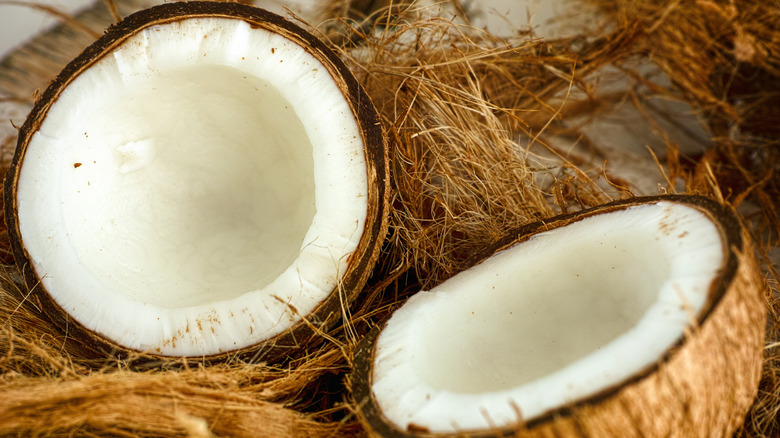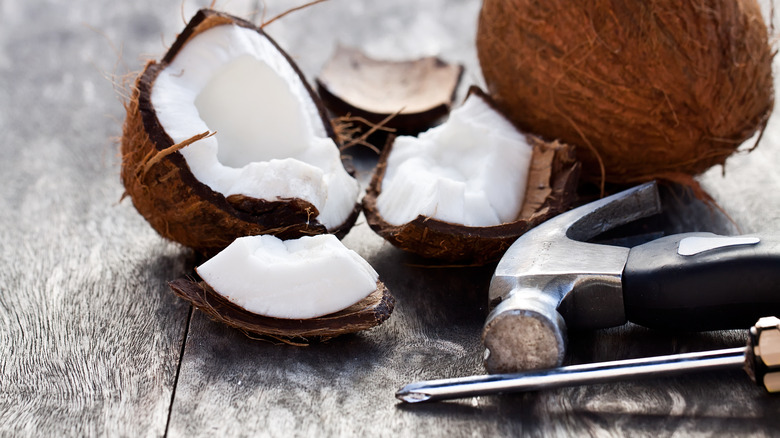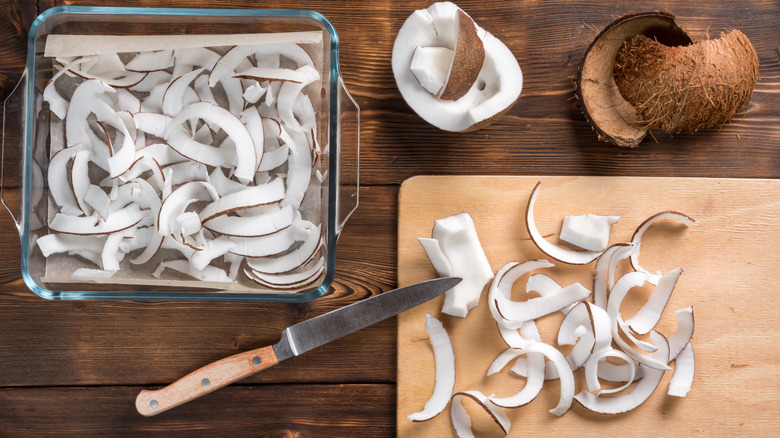The Unexpected Tool To Use When Removing A Coconut Husk
There are several things you can do when life gives you a big, fresh coconut. As an inexperienced coconut enthusiast, the most logical step is to hand it to someone who can effectively remove the husk and extract the water and the milky white meat for you to enjoy. Of course, things aren't always that simple.
Sometimes, you've got to take the layered tropical noggin into your own hands, and look for solutions in your tool cabinet. More specifically, grab your screwdriver to get the job done. No, seriously, the humble screwdriver is your best friend when it comes to coconut cracking quests. If the coconut vendors in India can do it with ease, so can you.
If you're dealing with a coconut that still has the outer green skin, aka the exocarp, you'll have to remove that first to get to the husk. To do so, take a hammer and strike it with the claw end to crack it. Once the green shell is cracked, you can pull it apart without much trouble. Removing the brown inner husk is the trickier part, and that's when the screwdriver comes in.
It's not as intimidating as you might think
The reason why we won't straight up suggest banging the coconut against the wall to crack the husk is because it hides something amazing within: coconut water. You want to extract it before removing the husk from the endosperm (the white meat), so on the off chance that the coconut fully cracks during the husk removal process, the water doesn't go to waste.
When you look at the coconut husk closely, you'll see it has three pores, commonly referred to as "eyes." Poke a hole through the softest eye using a screwdriver and drain the juice into a cup. You can give the coconut a gentle shake or tap to help the water pour out faster.
Now, to remove the husk, place the coconut on a steady surface and tap a flat-head screwdriver against it using a hammer until a crack appears. Then lodge the head of the screwdriver between the crack in the husk and the meat below, and slowly chip the husk away. Alternatively, you can bake the coconut in the oven at 375 degrees Fahrenheit on a baking sheet for about 20 minutes. The heat will cause the husk to crack, making it easy for you to pry it away from the meat with the screwdriver. Remember to wear protective gloves so you won't hurt yourself throughout the process.
On to the meat of the matter
Once you've cracked the tough nut and extracted the meat, rinse it thoroughly to remove any remaining bits of husk. Although the brown skin is perfectly safe to eat, you can easily peel it away using a vegetable peeler. You can enjoy the fresh coconut meat as-is, and it can be stored in the refrigerator for up to 5 days. But if you want to use it in recipes, go ahead and slice, grate, or shred it however you like, then dry it. You can use a cheese grater to make thin shavings and a vegetable peeler to make wider flakes.
To dry the shredded/flaked coconut in the oven, spread it on a baking sheet and pop it in at 140 degrees Fahrenheit for at least an hour. Keep an eye on it to prevent browning, and give the baking sheet a shake every 15 minutes to stir the flakes. If you're using a dehydrator, dry the coconut at 105 degrees Fahrenheit for at least 4 hours. Dried coconut can be stored in an airtight container for up to 6 months.
Use your dried coconut to make delicious snacks like crispy air fryer coconut tofu or add it to a tropical fruit salad. Coconut is also great for sweets like coconut cream pies or piña colada muffins. You can easily make coconut milk at home using a blender to use in recipes like a mushroom coconut curry or a coconut colada cocktail.


